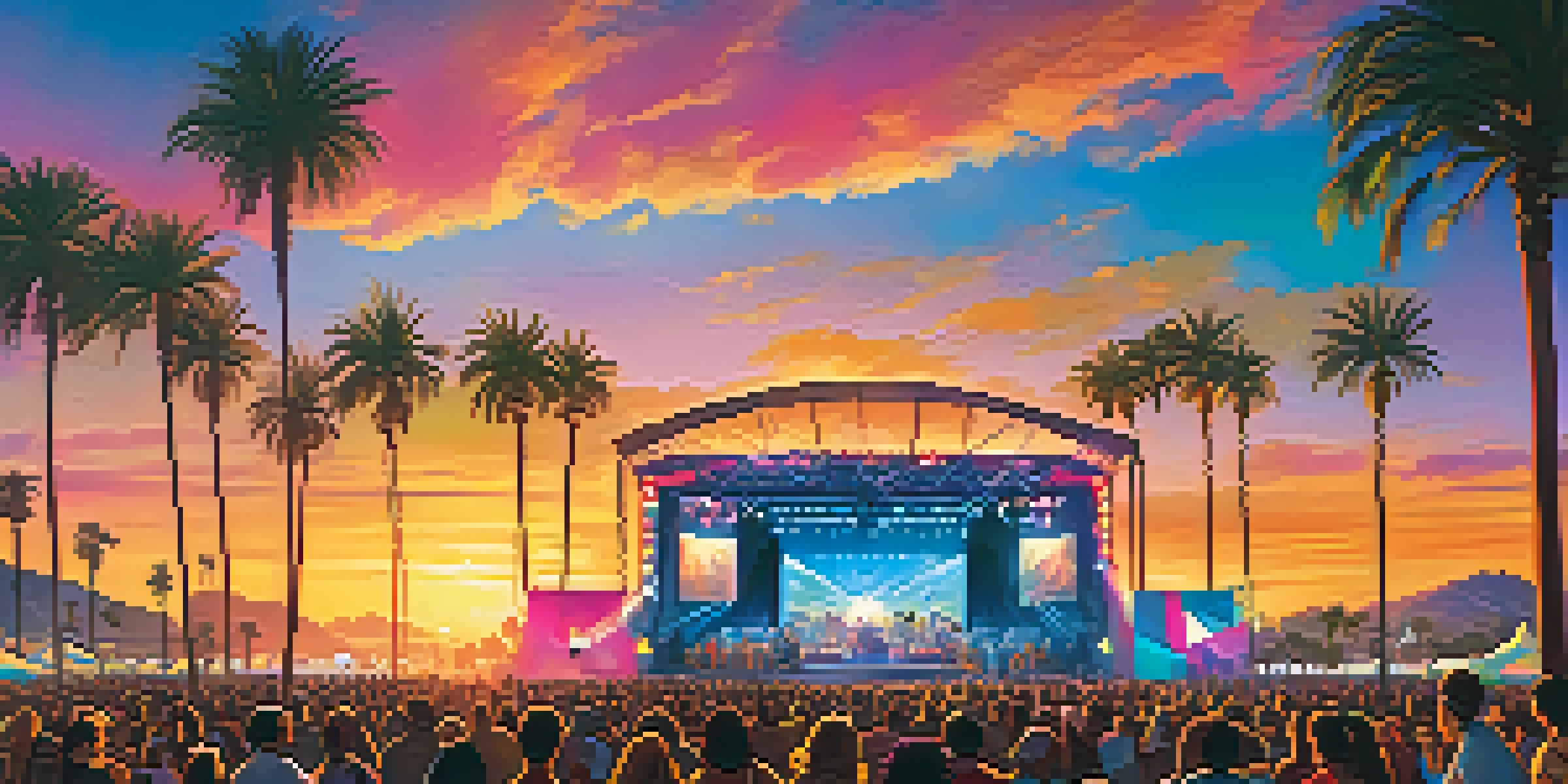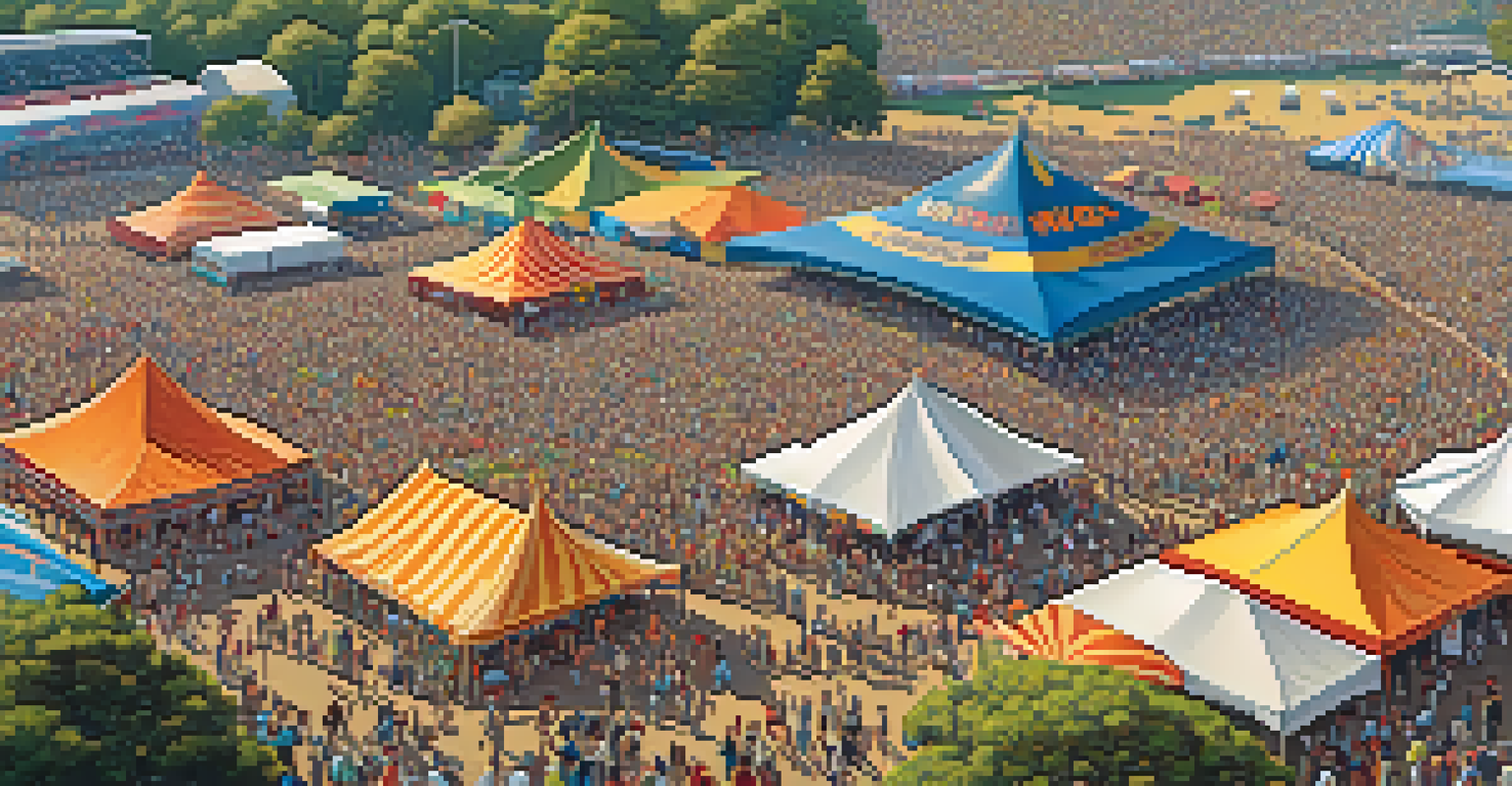The Role of Music Festivals in California's Tourism Industry

California's Music Festivals: A Major Tourist Attraction
California is home to some of the most iconic music festivals in the world, attracting millions of tourists annually. Events like Coachella and Outside Lands draw not only music lovers but also those looking to experience the unique culture of the Golden State. These festivals transform local areas into bustling hubs of activity, with visitors eager to explore everything from food to art while enjoying live performances.
Music can change the world because it can change people.
The allure of live music paired with California's stunning landscapes creates a unique experience that many travelers can’t resist. For instance, Coachella's desert setting enhances its appeal, making it a must-visit destination for both locals and international tourists. The energy and vibrancy of these events often lead attendees to extend their stay, further boosting local economies.
Moreover, the festival scene encourages visitors to discover lesser-known areas of California, contributing to a more diverse tourism experience. This influx of visitors can significantly benefit local businesses, from hotels and restaurants to shops and entertainment venues. In essence, music festivals serve as a powerful magnet, pulling tourists from all corners of the globe.
Economic Benefits of Music Festivals for Local Communities
The economic impact of music festivals extends far beyond ticket sales; they create jobs and generate revenue for surrounding communities. Local vendors, artists, and service providers often see a surge in business during festival weekends, as attendees seek food, accommodations, and unique experiences. This temporary increase in demand can lead to lasting relationships between festivals and local enterprises.

For example, many festivals partner with local businesses to provide food and merchandise, giving them a platform to showcase their offerings to a broader audience. This not only supports the local economy but also enriches the festival experience for attendees, who get to enjoy a taste of California's diverse culinary scene. It's a win-win situation that fosters community spirit and collaboration.
Festivals Boost Local Economies
Music festivals create jobs and generate significant revenue for surrounding communities by partnering with local businesses and attracting tourists.
Additionally, the revenue generated from festivals can be reinvested into local infrastructure and public services, enhancing the quality of life for residents. This cyclical benefit showcases how music festivals can be a catalyst for economic growth, ensuring that communities thrive long after the last note has played.
Cultural Significance of Music Festivals in California
California's music festivals are more than just entertainment; they are cultural phenomena that reflect the state's diverse population and artistic expression. These events often celebrate various genres, from rock and pop to jazz and hip-hop, showcasing the melting pot of influences that shape California's music scene. This diversity makes festivals inclusive spaces where people from all walks of life come together to share their love for music.
The power of music makes all the difference in the world.
Moreover, festivals often feature local artists, giving them a platform to reach new audiences. This emphasis on local talent fosters a sense of community and pride among residents, as they celebrate their cultural heritage. Festivals like the Monterey Jazz Festival not only highlight established artists but also nurture emerging musicians, ensuring the continued evolution of California's rich musical landscape.
As attendees immerse themselves in these vibrant celebrations, they gain a deeper appreciation for California's artistic contributions. This cultural exchange encourages tourists to explore beyond the music, delving into art, fashion, and lifestyle trends that emerge from these dynamic gatherings. In this way, music festivals serve as a cultural bridge, connecting people and ideas in a shared celebration of creativity.
The Role of Social Media in Promoting Festivals
In today’s digital age, social media plays a pivotal role in promoting music festivals and attracting tourists. Platforms like Instagram and TikTok allow festivals to showcase their unique experiences through vibrant visuals and engaging content. This online presence helps create buzz and anticipation, enticing potential attendees to purchase tickets and plan their trips to California.
The power of social media extends beyond promotion; it enables attendees to share their experiences in real-time. Festival-goers often post photos and videos, creating a sense of community and excitement that can influence their friends and followers to join in the fun. This organic marketing strategy significantly boosts awareness and interest in festivals, making them more appealing to a wider audience.
Cultural Celebrations Through Music
California's music festivals reflect the state's diverse culture and provide a platform for local artists, fostering community pride and artistic expression.
Additionally, festivals often engage with their audience through social media by hosting contests, sharing behind-the-scenes content, and providing updates. This interaction fosters a deeper connection between the festival and its attendees, making them feel like a part of something bigger. As a result, social media not only drives ticket sales but also enhances the overall festival experience.
Environmental Initiatives at Music Festivals
As awareness of environmental issues grows, many music festivals in California are taking steps to become more sustainable. Organizers are increasingly implementing eco-friendly practices, such as reducing waste, using renewable energy, and promoting recycling. This commitment to sustainability not only minimizes the ecological impact of these large events but also resonates with environmentally-conscious attendees.
For instance, festivals like Coachella have introduced initiatives to encourage carpooling and the use of public transportation, reducing the carbon footprint associated with travel. Additionally, many festivals partner with local environmental organizations to educate attendees about sustainability and conservation efforts. This creates a shared responsibility among festival-goers to protect the natural beauty of California.
By prioritizing environmental initiatives, music festivals can enhance their reputation and attract a demographic that values sustainability. This alignment not only benefits the planet but also attracts tourists who want to support eco-friendly events. Ultimately, the push for greener practices reflects a broader cultural shift towards responsible tourism, making California's music festivals leaders in the movement.
Music Festivals as a Platform for Social Change
Music festivals have historically served as platforms for social change, and California's festivals are no exception. Many events use their influence to raise awareness about pressing social issues, from climate change to social justice. By incorporating these themes into their messaging and lineups, festivals can engage attendees in meaningful conversations and inspire action.
For example, festivals often feature speakers and workshops focused on advocacy and activism, encouraging attendees to get involved in local causes. This not only enriches the festival experience but also cultivates a sense of community among like-minded individuals. The passion for music often translates into a passion for change, creating a powerful synergy between art and activism.
Sustainability in Festival Practices
Many California music festivals are adopting eco-friendly initiatives to reduce their environmental impact and resonate with environmentally-conscious attendees.
Furthermore, the visibility provided by these large gatherings can amplify the voices of marginalized communities, allowing them to share their stories and experiences. This cultural dialogue fosters understanding and empathy, encouraging attendees to reflect on their own roles in society. In this way, music festivals can transcend entertainment, becoming catalysts for positive social transformation.
Future Trends in California's Music Festival Scene
As the music industry evolves, so too do California's music festivals, adapting to changing trends and audience preferences. One notable trend is the rise of hybrid festivals, which combine in-person experiences with virtual components. This approach allows festivals to reach a broader audience, ensuring that even those unable to attend in person can still participate and enjoy the music.
Additionally, the integration of technology is becoming increasingly prevalent, with festivals utilizing apps for scheduling, networking, and real-time updates. This enhances the overall experience for attendees, making it easier to navigate the festival grounds and connect with fellow music lovers. As technology continues to advance, it will likely play an even larger role in shaping how festivals are experienced and enjoyed.

Looking ahead, inclusivity will remain a key focus, with festivals striving to create accessible environments for all. This includes offering accommodations for individuals with disabilities and promoting diverse lineups that reflect a wide range of musical styles and cultures. By embracing these trends, California's music festivals can continue to thrive and resonate with future generations of music enthusiasts.